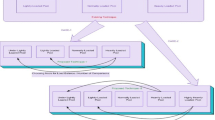Abstract
It is desirable in a distributed system to have the system load balanced evenly among the nodes so that the mean job response time is minimized. In this paper, we present a dynamic load balancing mechanism (DLB). It adopts a centralized approach and is network topology independent. The DLB mechanism employs a set of thresholds which are automatically adjusted as the system load changes. It also provides a simple mechanism for the system to switch between periodic and instantaneous load balancing policies with ease. The performance of the proposed algorithm is evaluated by intensive simulations for various parameters. The simulation results show that the mean job response time in a system implementing DLB algorithm is significantly lower than the same system without load balancings. Furthermore, compared with a previously proposed algorithm, DLB algorithm demonstrates improved performance, especially when the system is heavily loaded and the load is unevenly distributed.
Similar content being viewed by others
References
Bonomi F, Kumar A. Adaptive optimal load balancing in a nonhomogeneous multiserver system with a central job scheduler.IEEE Trans. on Computer, 1990, C-39(10): 1232–1250.
Eager D L, Lazowska E D, Zahorjan J. Adaptive load sharing in homogeneous distributed systems.IEEE Trans. on Software Engineering, 1986, SE-12(5): 662–675.
Krueger P, Shivaratri N G. Adaptive location policies for global scheduling.IEEE Trans. on Software Engineering, 1994, SE-20(6): 432–444.
Kunz T. The influence of different workload descriptions on a heuristic load balancing scheme.IEEE trans. on Software Engineering, 1992, SE-17(7): 725–730.
Lin H C, Raghavendra C S. A dynamic load-balancing polocy with a central job dispatcher (LBC).IEEE Trans. on Software Engineering, 1992, SE-18(2): 148–158.
Mirchandaney R, Towsley D, Stankovic J A. Analysis of the effects of delays on load balancing.IEEE Trans. on Computers, 1989, C-38(11): 1513–1525.
Ni L M, Xu C W, Gendreau T B. A distributed drafting algorithm for load balancing.IEEE Trans. on Software Engineering, 1985, SE-11(10): 1153–1161.
Siewiorek D P, Swarz R S. The Theory and Practice of Reliable System Design. Bedford, MA, Digital, 1982.
Theimer M M, Lantz K A. Finding idle machines in a workstation-based distributed system.IEEE Trans. on Software Engineering, 1989, SE-15(11): 1444–1458.
Zhou S. A trace-driven simulation study of dynamic load balancing.IEEE Trans. on Software Engineering, 1988, SE-14(9): 1327–1341.
Author information
Authors and Affiliations
Additional information
LAN Youran received his B.S. degree in radio electronics from Tsinghua University, Beijing, China; his M.S. degree in electrical engineering and his Ph.D. degree in computer science from Michigan State University, East Lansing, Michigan. In 1988, he joined the Department of Computer Science at the University of Missouri-Columbia, where he is currently an Associate Professor. His research interests include parallel and distributed systems, multicomputer interconnection networks, parallel algorithms design, and computer networks. Dr. Lan is a member of the IEEE Computer Society and the ACM.
Rights and permissions
About this article
Cite this article
Lan, Y. A dynamic load balancing mechanism for distributed systems. J. of Comput. Sci. & Technol. 11, 195–207 (1996). https://doi.org/10.1007/BF02943129
Received:
Issue Date:
DOI: https://doi.org/10.1007/BF02943129




